Getting enough iron in your diet is essential for energy, strong immunity, and overall wellness. Choosing the right foods high in iron can help prevent iron deficiency anemia, which often causes fatigue and poor concentration. Iron supports the production of hemoglobin, the protein that carries oxygen in your blood, and boosts healthy red blood cells.
A balanced diet that includes both heme iron from animal sources and non-heme iron from plants ensures better absorption and steady iron levels. By regularly eating nutrient-dense meals with iron-rich foods, you can maintain healthy blood, support brain function, and reduce the risk of long-term health problems.
Recommended Iron Intakes for Different Age Groups
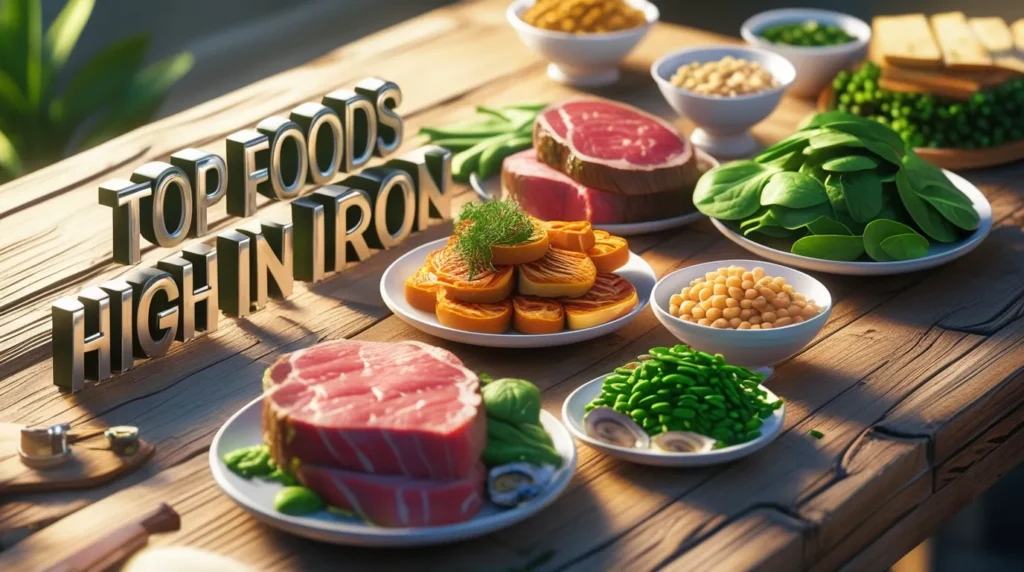
How much iron you need depends on your age, sex, and health condition.
The recommended dietary allowance (RDA) for iron in the USA is:
| Age Group | Recommended Daily Iron Intake |
|---|---|
| Infants (7–12 months) | 11 mg |
| Children (1–3 years) | 7 mg |
| Children (4–8 years) | 10 mg |
| Teens (9–13 years) | 8 mg |
| Teen girls (14–18 years) | 15 mg |
| Teen boys (14–18 years) | 11 mg |
| Adult men | 8 mg |
| Adult women (19–50 years) | 18 mg |
| Pregnant women | 27 mg |
| Breastfeeding women | 9–10 mg |
Pregnant women and teenagers need more iron due to rapid growth and blood volume changes.
Knowing the right intake helps you choose the best foods high in iron for your daily meals.
Types of Iron Heme vs. Non-Heme
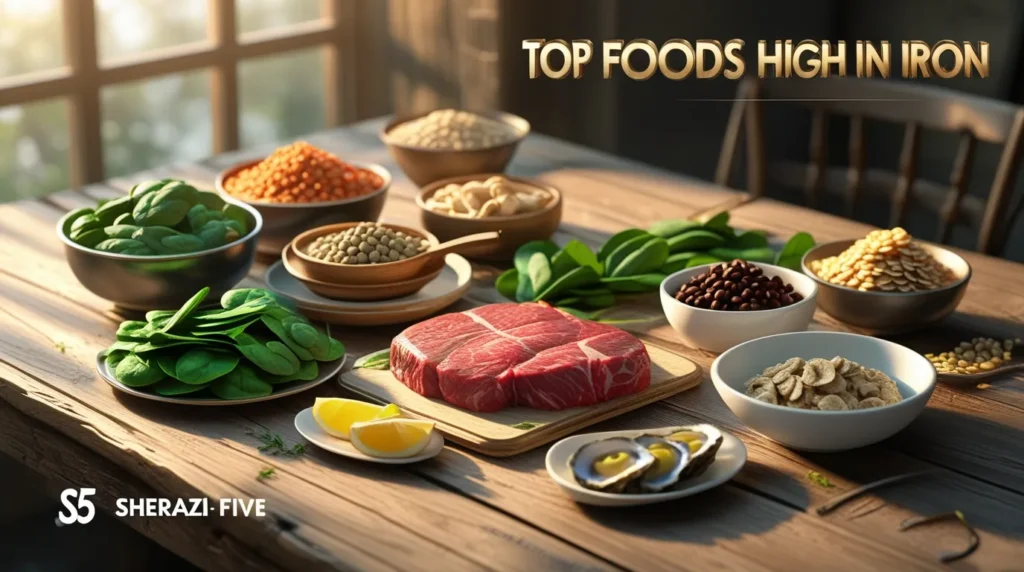
There are two main types of iron in our diet:
Heme iron: Found in animal-based foods like beef, chicken, and fish. Your body absorbs this type of iron more easily.
Non-heme iron: Found in plant-based foods like lentils, spinach, and beans. Its absorption can be boosted when eaten with foods rich in vitamin C, such as oranges or bell peppers.
Both types matter, but adding a variety of foods high in iron ensures you get enough of this vital mineral every day.
Best Foods High in Iron
Here’s a helpful table of some of the best natural sources of iron:
| Food Item | Type of Iron | Iron per Serving |
|---|---|---|
| Beef liver (3 oz) | Heme | 5 mg |
| Lean beef (3 oz) | Heme | 2.5 mg |
| Chicken (3 oz) | Heme | 1.3 mg |
| Oysters (3 oz) | Heme | 8 mg |
| Lentils (1 cup, cooked) | Non-Heme | 3.3 mg |
| Spinach (1 cup, cooked) | Non-Heme | 6 mg |
| Kidney beans (1 cup, cooked) | Non-Heme | 3 mg |
| Tofu (½ cup) | Non-Heme | 3.4 mg |
| Iron-fortified breakfast cereals (1 serving) | Non-Heme | up to 18 mg |
Eating a mix of these foods high in iron can help prevent iron deficiency and improve your energy levels.
Iron Intake and Body Status in the USA
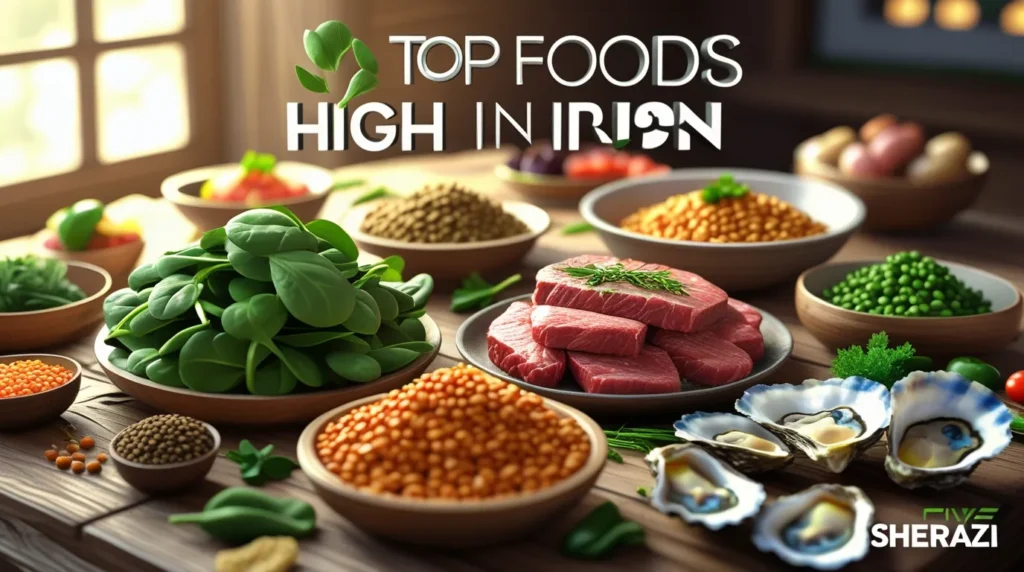
Most Americans get enough iron, but certain groups still struggle with low iron levels.
Risk factors include heavy periods, frequent blood donations, pregnancy, digestive disorders, or following a strict plant-based diet without proper planning.
Doctors often check ferritin levels and hemoglobin to see if your body has enough iron. If tests show low levels, increasing your intake of foods high in iron is often the first recommendation.
Iron Deficiency and Its Symptoms
Not getting enough iron can lead to iron deficiency anemia, a common nutritional problem in the USA.
Signs include:
Constant tiredness
Pale skin
Dizziness or headaches
Poor concentration
Weak immune response
If you notice these symptoms, it’s important to speak to a healthcare provider. Often, increasing foods high in iron and, in some cases, taking iron supplements can restore healthy levels.
Groups at High Risk of Iron Inadequacy
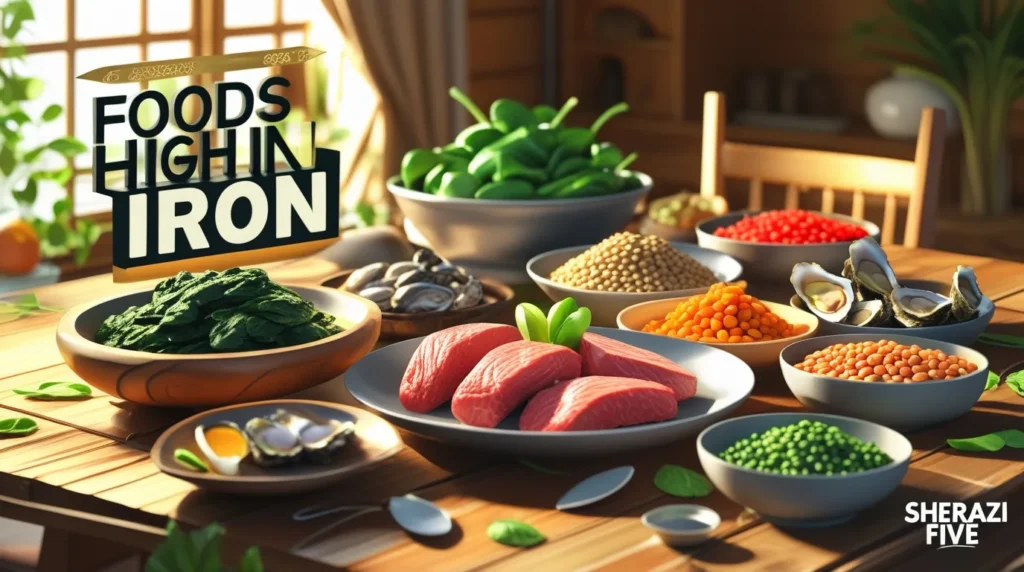
Some groups need extra attention to their iron intake:
Pregnant women need more iron to support the baby’s growth.
Infants and toddlers need iron for healthy brain development.
Women with heavy menstrual bleeding often lose more iron.
Vegetarians and vegans should focus on plant-based foods high in iron and combine them with vitamin C-rich foods to boost absorption.
Frequent blood donors need to replenish lost iron regularly.
Targeting these needs through a proper diet helps maintain healthy iron levels.
Iron’s Role in Pregnancy, Infants, and Chronic Conditions
During pregnancy, iron supports the baby’s brain and blood development. Low iron in expectant mothers can lead to low birth weight or early delivery.
Babies and toddlers with insufficient iron can face delays in learning and growth.
In people with chronic diseases such as cancer or heart failure, maintaining balanced iron levels is more challenging. Doctors often monitor their status closely and may recommend specific treatments alongside iron-rich meals.
Health Risks from Excessive Iron Intake
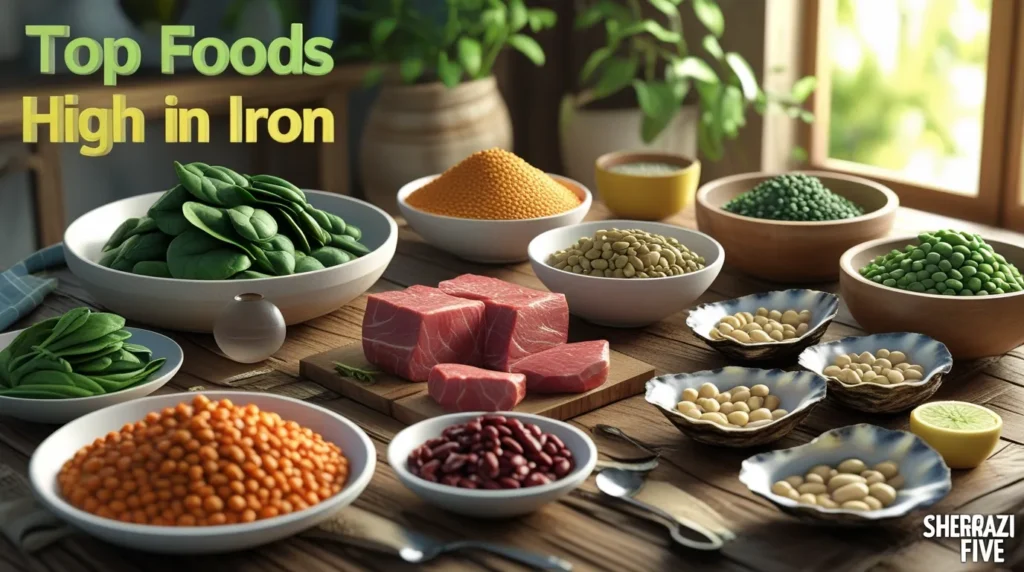
While iron is essential, too much can be dangerous.
High doses from supplements may cause:
Nausea and stomach pain
Constipation
Damage to internal organs in extreme cases
For adults, the safe upper limit is about 45 mg of iron per day.
People with hereditary conditions like hemochromatosis should avoid excess intake and only use iron supplements under medical guidance.
Iron Interactions with Medications
Iron can interact with certain medications.
For example, it can reduce the absorption of levothyroxine (a thyroid hormone treatment) and some antibiotics.
Taking calcium supplements or antacids at the same time as iron can also decrease how well iron is absorbed.
To get the full benefit, take iron supplements a few hours apart from these medications. Still, the best approach is to meet most needs from foods high in iron.
Building a Healthful Iron-Rich Diet
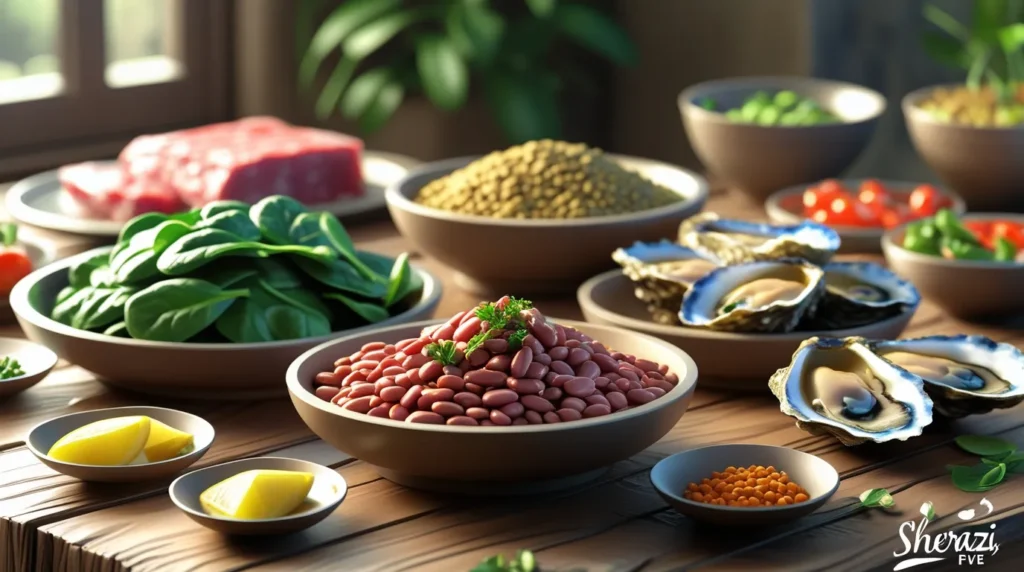
A balanced diet that includes a mix of foods high in iron is the best way to meet your needs naturally.
Here are some tips:
Combine non-heme iron foods with vitamin C-rich foods like strawberries or tomatoes.
Limit tea and coffee with meals, as they can block iron absorption.
Include lean meats, seafood, beans, lentils, nuts, and leafy greens regularly.
Choose iron-fortified cereals and whole grains for an added boost.
If your doctor suggests supplements, follow their instructions carefully to avoid excess iron.
Quick Comparison of Iron Sources
| Category | Examples | Iron Absorption |
|---|---|---|
| Heme Iron | Beef, chicken, oysters | Easily absorbed |
| Non-Heme Iron | Lentils, spinach, tofu | Lower absorption, improved with vitamin C |
| Fortified Foods | Cereals, bread | Good source, especially for vegetarians |
| Supplements | Ferrous sulfate, gluconate | For medical use only, risk of side effects |
Knowing which foods provide more absorbable iron helps you plan better meals.
Practical Tips for Everyday Iron Intake
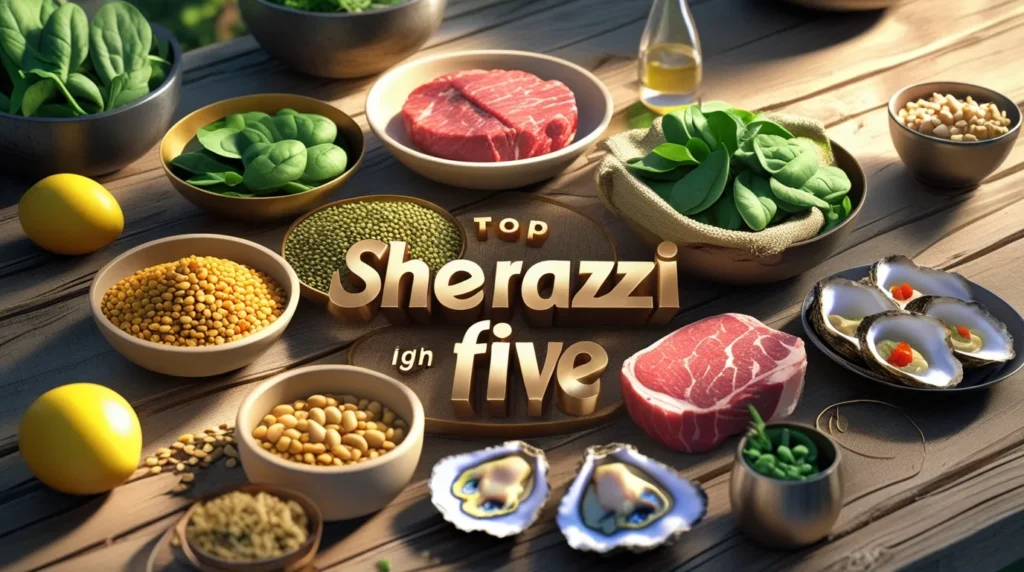
Eat a variety of foods high in iron instead of relying on just one source.
Don’t skip breakfast—many cereals are fortified with iron.
Snack on nuts and dried fruits like raisins for a quick iron boost.
Cook with cast-iron pans to increase the iron content in some meals.
Keep track of your iron levels with regular check-ups, especially if you belong to a higher-risk group.
Final Thoughts
Iron is vital for maintaining healthy energy levels, a strong immune system, and proper growth.
By including plenty of foods high in iron in your diet, you can prevent anemia and enjoy better overall health.
Whether you eat meat or follow a plant-based diet, planning your meals carefully can ensure you get the right amount of this essential nutrient.
Superfoods for Health – The Ultimate Guide to Boosting Your Well-being
AFQs
What food is the highest in iron?
Beef liver is one of the highest natural sources of iron, offering around 5 mg per 3-ounce serving.
How can I boost my iron?
Eat more iron-rich foods like red meat, lentils, and spinach, and pair them with vitamin C-rich foods to improve absorption.
Which fruits have high iron?
Fruits like dried apricots, prunes, and raisins are excellent plant-based sources of iron.
What drink is very high in iron?
Prune juice is one of the richest iron-boosting drinks, ideal for improving blood health.
Are eggs high in iron?
Eggs contain some iron, about 1 mg per large egg, but they’re not the richest source.
Is banana rich in iron?
Bananas have only a small amount of iron, so they aren’t considered a high-iron fruit.
What are the signs of lack of iron?
Fatigue, pale skin, dizziness, and brittle nails are common signs of iron deficiency.
What snack has the most iron?
Nuts, seeds, and roasted chickpeas are iron-rich snacks that are both healthy and energizing.
How to fix anemia quickly?
Eat iron-rich foods daily and take iron supplements under medical guidance to restore levels fast.
What to avoid when anemic?
Limit tea, coffee, and foods high in calcium during meals as they block iron absorption.
Is avocado high in iron?
Avocados provide only a small amount of iron and aren’t a primary iron source.
How long does it take to raise iron levels?
With proper diet and supplements, iron levels often improve within 4–6 weeks.
How can I increase my iron level fast?
Combine heme iron foods like lean meats with vitamin C-rich fruits to speed up absorption.
What causes anemia?
Anemia often occurs due to low iron intake, blood loss, chronic illness, or poor absorption.
Is cucumber high in iron?
Cucumbers contain very little iron and aren’t useful for boosting iron intake.
Is papaya high in iron?
Papaya has minimal iron but helps improve iron absorption thanks to its vitamin C content.
What to eat for anemia?
Include lean red meat, poultry, fish, lentils, beans, and fortified cereals in your meals.
Is peanut butter high in iron?
Peanut butter offers moderate iron, around 0.6 mg per tablespoon, and is a good snack choice.
What is the no. 1 iron food?
Beef liver tops the list for iron content among natural foods.
Can iron deficiency cause hair loss?
Yes, prolonged low iron can weaken hair follicles and lead to hair thinning or loss.
Are dates high in iron?
Dates are a sweet source of non-heme iron, great for boosting daily intake.
What drains iron from your body?
Chronic bleeding, ulcers, or frequent blood donation can reduce iron stores.
Are potatoes high in iron?
Potatoes contain a small amount of iron, with most in the skin, so keep the peel on.
Which fruit is best for anemia?
Dried apricots and raisins are top fruits for improving iron levels naturally.
What hurts when your iron is low?
Low iron often causes headaches, fatigue, and muscle weakness.
What not to eat with anemia?
Avoid tea, coffee, and excess dairy during meals as they can block iron absorption.
Is beetroot rich in iron?
Beetroot has moderate iron content and helps improve blood health when eaten regularly.
What kills iron absorption?
Tea, coffee, high-calcium foods, and some medications reduce the body’s ability to absorb iron.
What are the five strange symptoms of anemia?
Unusual cravings (like ice), brittle nails, cold hands, shortness of breath, and headaches.
Does low iron affect sleep?
Yes, iron deficiency can lead to restless sleep and insomnia in some people.
What can worsen anemia?
Poor diet, chronic diseases, infections, and heavy bleeding can make anemia worse.
What can be mistaken for iron deficiency?
Thyroid issues, vitamin B12 deficiency, and chronic fatigue can mimic anemia symptoms.
Can stress decrease iron absorption?
Chronic stress may impact digestion and reduce the body’s ability to absorb iron effectively.
Can anxiety cause low iron?
Anxiety doesn’t directly lower iron but may worsen fatigue and symptoms linked to anemia.
How do I tell if I’m low in iron?
Look for signs like constant tiredness, pale skin, brittle nails, and frequent headaches.
What are chronic stress symptoms?
Persistent fatigue, irritability, poor sleep, and frequent headaches are common signs of chronic stress.





Pingback: High Fiber Foods Chart For Constipation | Natural Remedies &